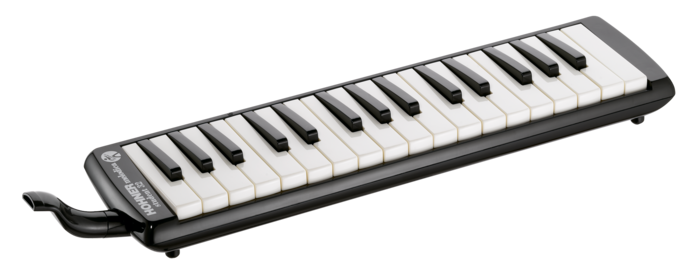Central Question:
How can we tell the difference—if there is one—between art for kids and art for adults?
Parts of a Hohner melodica (sold separately): mouthpiece, extension tube, individual keys; Partial list of varieties of melodica: twenty-six-key, thirty-two-key, thirty-six-key, alto, bass, Ocean, Fire; Precursors: sheng, sho, keyed Aeolian, pitch pipe, symphonium, harmonicor, goofus, keyboard sitar; Notable melodica appearances in recorded music: “Rockers Dub” by Augustus Pablo, “Melodica” by Steve Reich, “A Little Melodica” by Peter Tosh, “5:45” by Gang of Four, “Your Silent Face” by New Order, “And We Danced” by the Hooters, “The Chills” by the Receptionists, “Burning Hearts” by My Favorite, “Clint Eastwood” by Gorillaz, “Music with Horses” by Makoto Nomura, “Footsteps” by Pocketbooks.
Almost every melodica, mine among them, looks like a toy piano keyboard on top of a rectangle stuck to a big kazoo. The keys work like those on an accordion, opening up space for air to move through a reed; unlike accordion reeds, though, melodica reeds sound when the player blows air directly into the instrument, either through a thumb-sized nozzle at one end or through a siphon-like plastic tube. Playing a melodica is a visceral experience, even for beginners: your breath leads directly to each note, almost as if you could play a melody on a trumpet or a trombone on your first try. One note at a time, the melodica’s big, thick timbres suggest those of a distorted clarinet. Chords or tone clusters sound more like the instrument’s older relatives: the accordion, the harmonium, the harmonica. And the melodica isn’t very old. Related instruments date back to East Asian antiquity, but the word is a brand name, created by the Hohner company around 1959.
Melodicas became popular first, and fast, with music teachers in Japan, where grade-school curricula required harmonicas and keyboards. Made in Japan by Suzuki starting in 1961, melodicas counted as substitutes for both. They are often cheap, because all their parts can be plastic, and they’re easy for kids to carry—mine has a handle. And, because their tones come from discrete keys, they have no awkward, atonal learning period, as most woodwinds and strings do, during which beginners play squawks, honks, non-notes. Moreover, any adult who can play the piano can understand—and thus correct—where students place their hands. No wonder melodicas remain so important to music instructors, and show up so often in music aimed primarily at children; no wonder they’re sold in toy stores. Some versions—in bright colors, with shells shaped like cartoon animals—look very much like toys.
Yet the melodica has another heritage, too. Like other cheap, portable instruments (e.g. ukelele), it turned out to matter a lot on some tropical islands, in this case Jamaica, where the early reggae artist Augustus Pablo gave it lead roles in his music. In his hands the melodica could yearn, or growl, or carry a groove. Pablo supposedly started to play it when a child handed him one in a music store; until then, Jamaicans had seen it only in schools. Post-punk acts like Gang of Four picked it up from reggae, and used it in minor keys, or for harsh drones, as if to distinguish it further from children’s music.
Indeed, the melodica can be loud or aggressive—its volume can clear a room—but it’s hard to use it to show off. It’s so easy to play that, unlike the violin or piano or clarinet or guitar, it can make kids who play it sound uncommonly like adults. It can also make adults sound more like children: passionate, amateurish, sincere. That’s how it’s used by indie-pop and indie-folk groups, who sometimes combine it with other kid-friendly acoustic instruments. In modern composed music, its rec-room textures can seem either inviting or gratingly alien: contrast Steve Reich’s “Melodica,” which sets the instrument’s warmth against the coldness of tape-loop effects, with the improbably complex work of the all-melodica ensemble P-blot. Who would have thought this ultra-approachable instrument could get so technical, so weird?
So is the melodica a kids’ instrument that adults have adopted—as with composed music for toy piano—or a grown-up instrument that’s used as a toy? Its history keeps us from deciding. That same history could remind us how often adults can watch, and learn from, kids’ creations, just as children learn by watching adults. The melodica says— that is, its sound implies—that we should not divide any music, or perhaps any experience, so neatly between play for children and work for grown-ups, or between the amateur and the professional. It is of the essence of some music, some art, some life, to stay in between, neither one nor the other, always partly both.





